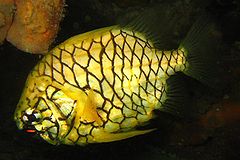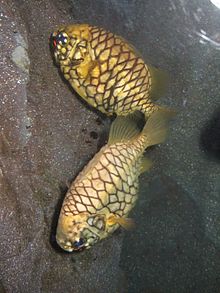- Pineapplefish
-
Pineapplefish 
Pineapplefish off Fly Point, New South Wales Scientific classification Kingdom: Animalia Phylum: Chordata Class: Actinopterygii Order: Beryciformes Family: Monocentridae Genus: Cleidopus
De Vis, 1882Species: C. gloriamaris Binomial name Cleidopus gloriamaris
De Vis, 1882The pineapplefish, Cleidopus gloriamaris, is a species of fish in the family Monocentridae, and the sole member of its genus. It is also known as the knightfish or the coat-of-mail fish, due to the armor-like scales covering its body, and the port-and-starboard light fish, as it has a pair of bioluminescent organs that are reminiscent of navigation lights on ships.[1] Its specific epithet is from the Latin gloria and maris, meaning "glory of the sea".[2]
Contents
Distribution and habitat
The pineapplefish is native to coastal waters off Queensland, New South Wales, and Western Australia.[3] It occurs at a depth of 6–200 meters (20–660 ft) in reefs and harbors.[4]
Description
The pineapplefish grows up to 22 cm (8.7 in) long.[4] It has a plump, rounded body almost completely covered in large, rough scales with sharp, backward-pointing spines. The head is large, with mucous pits bordered by rough ridges, and is armored with heavy bone. The snout is blunt and overhangs the wide mouth. The teeth are tiny and thin, present on the jaws, palatine, and vomer.[2][3] There are two pits containing bioluminescent bacteria on the lower jaw near the corners of the mouth, which are concealed when the mouth is closed.[5] This photophore is green in young fish and becomes more red as it ages.[6] The first dorsal fin consists of 5-7 strong spines; the spines are free of a membrane and point alternatingly left and right. The second dorsal fin contains 12 soft rays. Each pelvic fin contains an enormous spine, nearly as long as the head, and 3-4 rudimentary rays. The pelvic spine can be locked erect at a right angle to the body. The anal fin contains 11-12 rays and the pectoral fins 14-15 rays.[2][4]
The scales of the pineapplefish are yellow to whitish with black rear margins, forming the striking pattern that gives this fish its name. The lips, chin, and parts of the jaw are black. There is a red stripe on the lower jaw running to the photophore.[3] This species is very similar to the pinecone fishes of the genus Monocentris, and is placed within that genus by some authors. Cleidopus differs from Monocentris in having a narrow preorbital bone and in the position of its light organs, which are near the tip of the lower jaw in Monocentris.[5] This species also differs from the Japanese pineapplefish (Monocentris japonica) in having a more rounded snout.[6]
Biology and ecology
Due to its small fins and rigid armor, the pineapplefish is a weak swimmer.[2] A nocturnal species, it may be found inside caves and under rocky ledges during the day.[7] In the Fly Point Halifax Park Aquatic Preserve, New South Wales, a small group of pineapplefish has been documented under the same ledge for at least 7 years, and another group under a different ledge for 3 years.[8] At night, this species ventures out onto sandy flats to feed, using its light organs to illuminate small shrimp. The light may also be used to communicate with conspecifics.[7] The light of the pineapplefish is produced by symbiotic colonies of the bacteria Vibrio fischeri within its photophores.[9] V. fischeri are also found free-living in sea water and are naturally released from the pineapplefish's photophores. However, their luminescence dims a matter of hours after being released.[10] This species has lived up to 10 years in captivity.[8]
Relationship to humans
The pineapplefish is moderately common in deep water, but due to its retiring nature, for some time after its initial discovery it was only known from specimens tossed ashore by storms.[3] This fish is sometimes collected by commercial trawlers, and is popular with saltwater fish aquarists.[1][7] It is fairly hardy, but must be provided with rocky hiding places and live food.[11]
References
- ^ a b Burgess, W. and Axelrod, H.R. (1973). Pacific Marine Fishes (second ed.). T.F.H. Publications. ISBN 0876661231.
- ^ a b c d Ogilby, J.D. (1900). "Contributions to Australian Ichthyology". The Proceedings of the Linnean Society of New South Wales For the Year 1899. F. Cunninghame & Co..
- ^ a b c d Wheeler, A. (1985). The World Encyclopedia of Fishes. Macdonald & Co. (Publishers) Ltd.. ISBN 0356107159.
- ^ a b c Froese, Rainer, and Daniel Pauly, eds. (2009). "Cleidopus gloriamaris" in FishBase. March 2009 version.
- ^ a b Smith, J.L.B., M.M. and Heemstra, P. (2003). Smiths' Sea Fishes. Struik. ISBN 1868728900.
- ^ a b McGrouther, M. (Nov. 2004) Pineapplefish, Cleidopus gloriamaris. Australiam Museum Fish Site. Retrieved on March 13, 2009.
- ^ a b c Burke, D. (2005). The Complete Burke's Backyard: The Ultimate Book of Fact Sheets. Murdoch Books. ISBN 1740457390.
- ^ a b Harasti, D. Pineapple Fish (Cleidopus gloriamaris). The Underwater Photo Gallery - Dave Harasti. Retrieved on March 13, 2009.
- ^ Fitzgerald, J.M. (Mar. 1977). "Classification of luminous bacteria from the light organ of the Australian Pinecone fish, Cleidopus gloriamaris". Archives of Microbiology 112 (2): 153–156. doi:10.1007/BF00429328.
- ^ Nealson, K.M., Haygood, M.G., Tebo, B.M., Roman, M., Miller, E. and McCosker, J.E. (Mar. 1984). "Contribution by Symbiotically Luminous Fishes to the Occurrence and Bioluminescence of Luminous Bacteria in Seawater". Microbial Ecology 10 (1): 69–77. doi:10.1007/BF02011596.
- ^ Pineapple fish - Cleidopus gloriamaris. Aquariums Life. Retrieved on March 13, 2009.
Categories:
Wikimedia Foundation. 2010.

